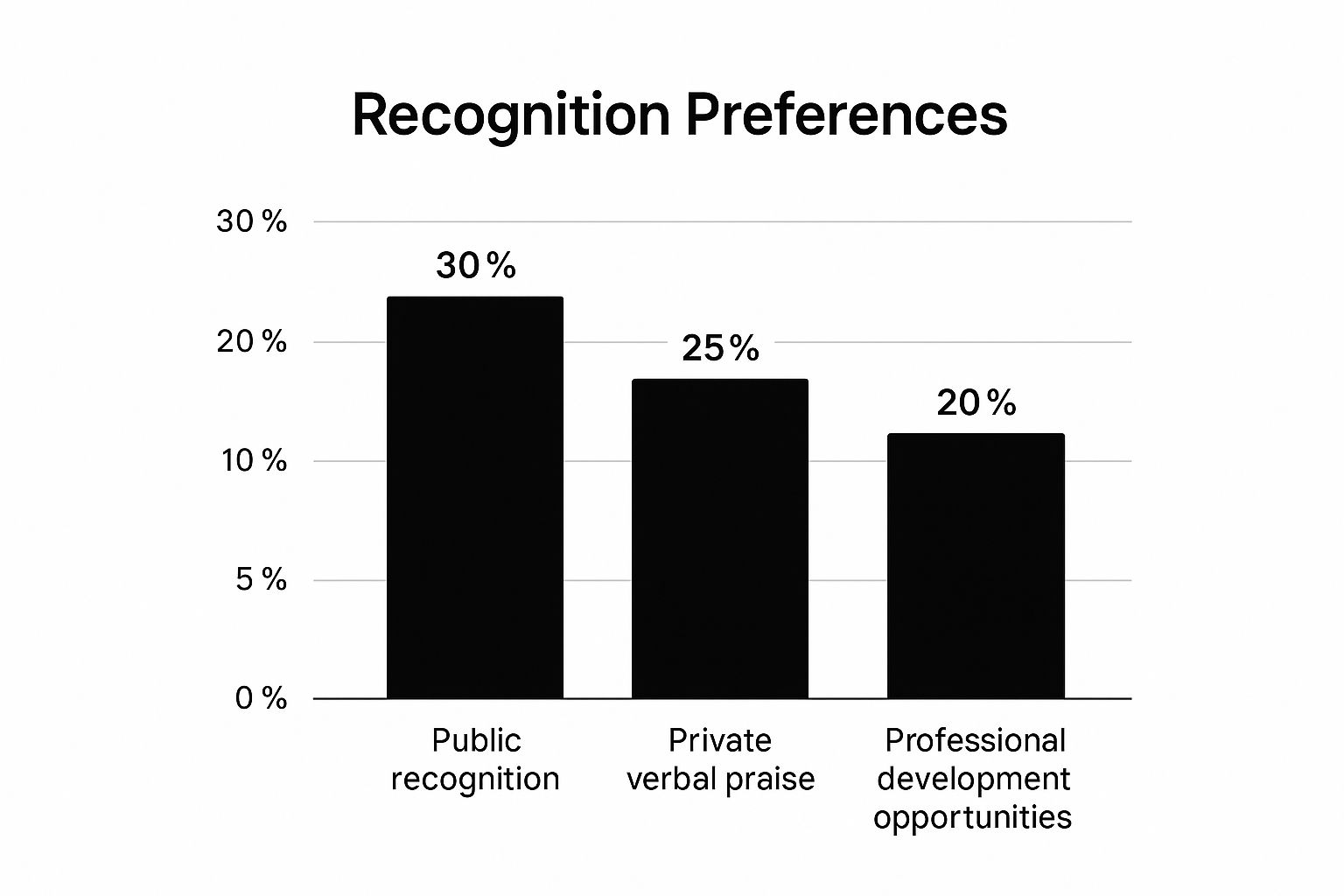Unlocking Employee Potential Through Recognition
Want a more engaged and productive team? Understanding how your employees prefer to be recognized is key. This list of six recognition survey questions for employees provides valuable insights to improve your current recognition programs and create a culture of appreciation. Learn how to gauge employee satisfaction, identify preferred recognition methods, and uncover potential roadblocks, using questions like "How satisfied are you with the recognition you receive?" and "What types of recognition are most meaningful to you personally?". These insights will help you build a thriving workplace where everyone feels valued.
1. How likely are you to recommend this company as a great place to work? (eNPS)
This seemingly simple question is a powerhouse when it comes to understanding employee sentiment and the effectiveness of your recognition programs. Known as the Employee Net Promoter Score (eNPS), it's an adaptation of the widely used Net Promoter Score (NPS) methodology, specifically tailored to gauge employee loyalty and satisfaction within the workplace. By asking employees how likely they are to recommend their company as a great place to work, you gain valuable insights into their overall experience, including how valued and recognized they feel. The eNPS provides a single, easily digestible metric that correlates strongly with employee satisfaction, engagement, and ultimately, retention. It's a crucial tool for any organization, from startups to large corporations, looking to improve their workplace culture and boost employee morale.

The eNPS question uses a 0-10 scale, providing a consistent measurement framework. This scale allows you to segment your employees into three distinct categories: Promoters (9-10), Passives (7-8), and Detractors (0-6). Promoters are your enthusiastic employees, acting as brand ambassadors for your company. Passives are generally satisfied but could be swayed to leave by a competitor. Detractors are actively dissatisfied and may be negatively impacting your workplace culture. Understanding the distribution of your employees across these categories provides a clear picture of your workforce's overall sentiment.
One of the key benefits of the eNPS is its benchmarkability. The score allows you to compare your company's performance against industry averages, giving you a clear understanding of where you stand in terms of employee satisfaction and loyalty. This benchmarking data can be invaluable for identifying areas for improvement and setting realistic goals for your recognition programs. The strong correlation between eNPS and recognition effectiveness makes it an essential tool for measuring the impact of your recognition initiatives.
Companies like Microsoft, Salesforce, and Adobe have successfully integrated eNPS into their employee recognition strategies. Microsoft utilizes eNPS to track the effectiveness of its recognition programs across global teams, ensuring consistency and impact. Salesforce correlates eNPS scores with its "Ohana" recognition culture initiatives, highlighting the link between a positive work environment and employee loyalty. Adobe tracks eNPS quarterly alongside its peer recognition platform metrics, providing a holistic view of employee recognition and its impact on overall satisfaction. These examples demonstrate the versatility and effectiveness of eNPS across different industries and organizational structures.
While the eNPS offers valuable insights, it's important to be aware of its limitations. It doesn't provide specific, actionable feedback on what aspects of recognition employees value most. The score can also be influenced by factors beyond recognition, such as compensation, work-life balance, and management styles. Furthermore, the eNPS may not capture nuanced recognition preferences, as it provides a broad overview rather than granular details.
To maximize the effectiveness of the eNPS question in your recognition surveys, consider these actionable tips:
- Follow up with open-ended questions: Gain deeper context by asking "Why?" after the eNPS question. This qualitative data can illuminate the drivers behind the scores and provide specific areas for improvement.
- Track trends over time: Focus on the trajectory of your eNPS score rather than fixating on a single data point. This allows you to monitor the impact of your recognition programs and identify long-term trends in employee sentiment.
- Segment by department: Identify recognition gaps and tailor your programs by analyzing eNPS scores by department or team. This allows you to address specific needs and create more targeted recognition initiatives.
- Use scores to prioritize recognition program improvements: Let your eNPS data guide your decisions. Focus on areas where scores are low and implement changes based on employee feedback.
The eNPS is a powerful, yet simple tool for measuring employee sentiment and the effectiveness of your recognition programs. By understanding its features, benefits, and limitations, you can effectively utilize this metric to create a more positive and rewarding workplace environment. Its ease of implementation, strong correlation with employee retention, and benchmarkability make it a valuable asset for organizations of all sizes, solidifying its place as a crucial element in any robust recognition survey. By incorporating these best practices, you can leverage the eNPS to cultivate a culture of recognition and drive positive change within your organization.
2. How satisfied are you with the recognition you receive for your work?
This question cuts to the core of employee sentiment regarding recognition. It directly assesses how content your employees are with the current recognition programs and practices within your organization. By understanding this fundamental metric, you gain valuable insight into the effectiveness of your efforts and can pinpoint areas where employee expectations and the reality of recognition delivery may be misaligned. This question acts as a crucial starting point for building a robust and impactful recognition program. It allows you to gauge the overall “temperature” of employee satisfaction with recognition, providing a baseline against which future improvements can be measured.

This question typically utilizes a 5-point Likert scale, ranging from "Very Dissatisfied" to "Very Satisfied." This structured approach allows for easy quantification and tracking of employee sentiment. The power of this question lies in its adaptability. You can segment the responses by different types of recognition, such as peer-to-peer, manager-to-employee, or formal company programs. This granular view helps identify specific areas of strength and weakness within your overall recognition strategy. For instance, you might discover high satisfaction with peer recognition but low satisfaction with formal recognition programs, allowing you to focus your improvement efforts where they are most needed. It also allows for an assessment of both the frequency and the quality of recognition. While frequent recognition is important, it won't boost morale if employees perceive it as insincere or insignificant. This question helps uncover whether employees feel valued and appreciated for their contributions.
Companies like Google, Zappos, and Deloitte understand the importance of gauging recognition satisfaction. Google incorporates this question into their quarterly "Googlegeist" survey to monitor trends and ensure their recognition programs resonate with their employees. Zappos, renowned for its strong company culture, includes recognition satisfaction as part of their employee surveys to maintain their vibrant and appreciative work environment. Deloitte utilizes this question in their performance management pulse surveys to gain real-time feedback and address recognition issues promptly. These examples demonstrate how this simple yet powerful question can be integrated into various feedback mechanisms, regardless of company size or industry.
Actionable Tips for Implementation:
- Pair with Related Questions: To gain a deeper understanding of employee perspectives, combine this question with others about the frequency and types of recognition received. This holistic approach provides a richer context for interpreting the satisfaction scores.
- Segment Your Data: Analyze responses across different demographics (age, tenure, department, etc.) to identify specific needs and tailor recognition efforts accordingly. For example, younger employees might value public acknowledgement, while more senior employees might appreciate private expressions of gratitude.
- Budget Allocation: Use the results to inform your recognition program budget allocation. If employees express dissatisfaction with formal recognition programs, you can allocate resources to improve existing programs or develop new ones.
- Follow-Up with Focus Groups: For segments expressing low satisfaction, conduct follow-up focus groups to delve deeper into the reasons behind their dissatisfaction. This qualitative data can provide invaluable insights for designing more effective recognition strategies.
- Track Progress Over Time: Regularly asking this question allows you to track improvements in recognition satisfaction over time. This data provides concrete evidence of the impact of your recognition initiatives.
Pros of using this question:
- Direct Measurement: Provides a clear and concise measure of recognition effectiveness.
- Trackable Progress: Allows for easy monitoring of improvements over time.
- Identifies Areas for Improvement: Pinpoints specific areas requiring attention within recognition programs.
- Engaging Insights: Highly correlated with employee engagement and overall morale.
Cons of using this question:
- Recency Bias: Responses may be influenced by recent recognition events, either positive or negative.
- Lack of Specificity: Doesn't always pinpoint the type of recognition lacking.
- Subjectivity: Individual expectations of recognition can vary, influencing responses.
By implementing this question effectively and analyzing the results thoughtfully, you can create a culture of recognition that fosters employee engagement, boosts morale, and drives organizational success. The insight gained from this question alone can be transformative in shaping a recognition program that truly resonates with your employees. Popularized by organizations like Gallup, SHRM, and WorldatWork, this question has become a staple in understanding and improving employee recognition programs.
3. How often do you receive recognition from your immediate supervisor?
This recognition survey question focuses on the frequency of recognition employees receive directly from their supervisors. It's a crucial metric for understanding the health of employee-manager relationships and identifying areas for improvement within your recognition programs. This question taps into a critical aspect of employee experience: the regular affirmation and appreciation of their efforts by their direct managers. Research consistently shows that manager-delivered recognition is the most impactful form, influencing not only job satisfaction but also overall performance and retention. By asking this question, organizations gain insights into whether managers are actively fulfilling their role as primary recognition providers and can identify potential coaching needs. This question helps organizations understand the baseline of recognition frequency and track progress over time. It's a powerful tool for building a stronger, more engaged workforce, especially in fast-paced environments like startups, small businesses, and corporate offices, where consistent recognition can significantly impact morale and productivity.

This particular question leverages a frequency scale, typically offering options like "Daily," "Weekly," "Monthly," "Quarterly," "Rarely," and "Never." This allows for quantifiable data collection and makes it easy to benchmark results and track improvements over time. The focus on the direct manager relationship is intentional, as this relationship is often the most significant in an employee's daily work life. Identifying manager training needs is another key feature of this question. By analyzing the responses, organizations can pinpoint managers who might benefit from further coaching on delivering effective recognition, thereby enhancing the overall employee experience. The frequency of manager recognition also correlates strongly with the overall quality of the employee-manager relationship, offering a valuable indicator of team health and potential areas of friction.
Companies like Facebook (Meta), IBM, and Netflix have recognized the value of tracking manager recognition frequency. Meta incorporates this question into their semi-annual engagement surveys, allowing them to monitor trends and identify areas needing attention. IBM uses this metric in their manager effectiveness scorecards, tying recognition directly to performance evaluations and providing a tangible incentive for managers to prioritize recognition. Netflix includes this question in their 'Keeper Test' culture assessments, ensuring that recognition is a core component of their performance-driven culture. These examples demonstrate the versatility of this question and its applicability across different organizational structures and industries, from tech giants to BPO providers and plug-and-play office spaces.
There are several benefits to using this question in your employee recognition surveys. It directly identifies coaching opportunities for managers, enabling organizations to provide targeted training and support to improve recognition practices. It measures the effectiveness of the most impactful recognition source – the direct manager – providing valuable insights into the overall recognition ecosystem. The data collected is easy to benchmark and track, allowing organizations to monitor progress and demonstrate the impact of recognition initiatives. The results are directly actionable through manager training, providing a clear path for improvement and ensuring that resources are allocated effectively.
While powerful, this question does have some limitations. It doesn't measure the quality of recognition, only the frequency. A manager might provide frequent but superficial recognition, which might not resonate with employees. Responses may also vary based on individual management style preferences and team dynamics. Some managers are naturally more expressive, while others may prefer a more reserved approach. The question also doesn’t account for differing employee recognition preferences. Some employees value public praise, while others prefer private acknowledgment.
To maximize the effectiveness of this question, consider implementing the following tips: Set clear expectations that recognition should occur at least weekly, fostering a culture of regular appreciation. Use the results to identify high-performing recognition managers and share their best practices with others. Create manager training programs specifically addressing low-scoring areas, equipping managers with the skills and knowledge to deliver effective recognition. Finally, pair this question with other manager effectiveness training programs for a holistic approach to leadership development.
This question's prominence in popular management methodologies, such as Gallup's Q12 engagement survey, Ken Blanchard's situational leadership model, and Marcus Buckingham's strengths-based management, underscores its significance in creating a positive and productive work environment. By understanding how often employees receive recognition from their immediate supervisor, organizations can take meaningful steps toward fostering a culture of appreciation and driving employee engagement.
4. What types of recognition are most meaningful to you personally?
This question is crucial for building a successful employee recognition program. It directly addresses the core of effective recognition: understanding what truly motivates and resonates with your employees. By including this question in your recognition survey, you gather valuable data about individual and demographic preferences, enabling you to create personalized recognition strategies that maximize impact and align with employee values. This personalized approach not only boosts morale and productivity but also strengthens your company culture by demonstrating that you value your employees as individuals. This is why it deserves a prominent place in any comprehensive recognition survey.
This preference-mapping question typically utilizes a multiple-choice format, presenting employees with a range of recognition options. These options might include public praise, private feedback, monetary rewards, growth opportunities, low-cost perks, or company-specific awards. The power of this question lies in its customizability; you can tailor the choices to reflect the specific recognition options available within your organization. This ensures the data collected is directly relevant and actionable.
The insights gleaned from this question can reveal valuable trends. For instance, you might discover that younger generations prefer public acknowledgement and professional development, while more experienced employees value private feedback and monetary rewards. Understanding these generational and cultural recognition preferences allows you to create a diverse recognition program that caters to everyone. This question enables personalized recognition approaches, ensuring each employee feels valued and appreciated in a way that resonates with them.
Companies like Spotify, Airbnb, and HubSpot have successfully implemented personalized recognition strategies based on employee preference data. Spotify uses the data to customize its recognition platform offerings, ensuring employees have access to the rewards they value most. Airbnb tailors its recognition approaches based on employee preference surveys, fostering a culture of appreciation that resonates across different teams and departments. HubSpot personalizes its culture awards based on individual preferences, making the awards more meaningful and impactful.
Pros of using this question:
- Enables personalized recognition strategies: By understanding individual preferences, you can tailor recognition to be more impactful.
- Helps optimize recognition program mix: Data reveals which types of recognition are most valued, allowing for efficient allocation of resources.
- Identifies cost-effective recognition preferences: You may discover that highly valued forms of recognition are also low-cost, maximizing impact while minimizing expenses.
- Improves recognition impact through personalization: Recognition that aligns with individual preferences is more likely to boost morale and motivation.
Cons of using this question:
- Preferences may change over time: Regular surveys are necessary to keep up with evolving employee preferences.
- Can be challenging to accommodate all individual preferences: Finding a balance between personalization and feasibility is important.
- May create expectations for personalized treatment: Transparent communication about the recognition program is essential.
Actionable Tips for Implementation:
- Offer 5-7 recognition type options to choose from: This provides sufficient choice without overwhelming employees.
- Update preferences annually as employees develop: Regularly revisiting preferences ensures your program stays relevant.
- Train managers to ask about and remember individual preferences: Empowering managers to personalize recognition strengthens team dynamics.
- Use data to guide recognition program investment decisions: Allocate resources to the recognition types that are most valued by your employees.
This approach to understanding employee recognition preferences has been popularized by experts like Gary Chapman, author of "The 5 Love Languages," which has been adapted for the workplace, and Paul White, who co-authored "The 5 Languages of Appreciation in the Workplace." Recognition platform providers like Bonusly have also championed the importance of personalized recognition.
The following bar chart visualizes sample data collected from such a survey.

This bar chart visualizes the top three preferred recognition types among a surveyed group of employees. As shown, public recognition leads the way with 30% preference, followed by private verbal praise at 25%, and professional development opportunities claiming 20%. This indicates a preference for both visible appreciation and opportunities for growth within this particular group.
By incorporating this question into your employee recognition survey, you gain crucial insights that empower you to create a truly impactful and personalized recognition program. This leads to a more engaged, motivated, and productive workforce, benefiting both individual employees and the organization as a whole.
5. Do you feel your contributions are valued by senior leadership?
This recognition survey question delves into a crucial aspect of employee experience: the perceived connection between individual contributions and their valuation by senior leadership. For startups, small businesses, freelancers, BPO providers, and corporate offices alike, understanding this dynamic is paramount for fostering a positive and productive work environment. This question, targeting the effectiveness of "recognition survey questions employees," helps gauge whether recognition is effectively cascading from the top down and whether employees feel seen and valued by those making key decisions. It's a powerful tool for measuring the depth of your organizational recognition culture and identifying potential leadership visibility gaps.
This question operates on the principle that employees are more likely to be engaged, motivated, and committed to an organization when they feel their work is recognized and appreciated, especially by those in leadership positions. A lack of perceived value from senior leadership can lead to disengagement, decreased productivity, and ultimately, higher turnover rates. By including this question in your employee recognition survey, you gain valuable insights into how well your organization is communicating appreciation from the top down.
The question can be formatted as a simple Yes/No response or utilize a more nuanced Likert scale (e.g., Strongly Disagree to Strongly Agree) to capture varying degrees of sentiment. The Likert scale allows for more granular data analysis and can reveal subtle trends in employee perception. Regardless of the format, this question directly measures top-down recognition effectiveness and helps identify any disconnects between leadership's intentions and employees' experiences. This is particularly relevant for organizations like Plug and Play, which thrive on innovation and collaboration, where feeling valued by leadership can significantly impact individual contributions.
Several successful companies actively use this type of feedback to strengthen their recognition programs and improve overall employee engagement. Microsoft CEO Satya Nadella, for instance, is known for using employee feedback, including responses to questions about leadership recognition, to inform his communication strategies and ensure his recognition efforts resonate with employees. Similarly, Southwest Airlines tracks this metric diligently to maintain its renowned positive culture across all organizational levels, demonstrating the importance of top-down recognition in sustaining a strong company culture. Patagonia, known for its values-driven approach, also integrates this question into their employee surveys, measuring leadership recognition effectiveness as a key component of their overall cultural assessment. These examples highlight the value of this question for organizations of all sizes and industries.
Tips for Effective Implementation and Action:
- Share the results with senior leadership: Transparency is key. Sharing the aggregated and anonymized results with senior leaders demonstrates the impact of their actions (or inaction) on employee perception and provides concrete data to inform leadership development programs and recognition strategies.
- Create structured opportunities for leadership-employee recognition interactions: Bridge the gap between senior leadership and employees by implementing structured programs that facilitate meaningful interactions and recognition opportunities. This could include mentorship programs, regular "coffee with the CEO" sessions, or dedicated platforms for leadership to publicly acknowledge employee contributions.
- Leverage town halls and all-hands meetings for recognition visibility: These forums provide excellent opportunities for senior leaders to publicly recognize and appreciate employee achievements, reinforcing the message that contributions are valued at the highest levels. This is especially effective in larger organizations or those with distributed teams.
- Train leaders on recognition communication strategies: Equip your leaders with the skills and tools they need to effectively communicate appreciation and recognition. This could involve workshops on effective feedback, training on using recognition platforms, or simply providing guidelines on how to express genuine appreciation.
Pros:
- Identifies critical leadership communication gaps, enabling targeted improvements.
- Provides a comprehensive measure of the depth and effectiveness of the organizational recognition culture.
- Demonstrates a strong correlation with employee retention, highlighting its importance in talent management.
- Guides the development and implementation of targeted senior leadership engagement strategies.
Cons:
- Senior leaders, especially in larger organizations, may have limited direct interaction with all employees, which can influence perceptions.
- Responses can be influenced by recent organizational changes or events, creating temporary fluctuations in perceived value.
- The question may reflect the effectiveness of leadership communication rather than the actual valuation of employee contributions, requiring careful interpretation of the results.
By incorporating this powerful question into your recognition surveys, you gain invaluable data to enhance your recognition programs, strengthen leadership communication, and foster a culture of appreciation that drives employee engagement and retention. It’s a key element for any organization looking to implement effective "recognition survey questions employees" and build a thriving workforce.
6. What barriers prevent you from recognizing others or receiving recognition at work?
This question is arguably one of the most valuable recognition survey questions employees can answer. It delves into the heart of why recognition programs may not be thriving, offering crucial diagnostic insights into the underlying issues. By asking employees directly about the obstacles they face, organizations can uncover hidden roadblocks hindering a culture of appreciation. This open-ended question invites employees to share their specific experiences and perspectives, allowing for a richer understanding of the challenges that need to be addressed. Its inclusion in your employee recognition survey can significantly elevate the effectiveness of your recognition initiatives.
This question works by prompting employees to reflect on their own experiences and identify both systemic and individual barriers that prevent them from giving or receiving recognition. Unlike multiple-choice questions that may restrict answers, this open-ended format allows for more nuanced and detailed feedback. Employees can articulate the specific challenges they encounter, providing invaluable information for improving the recognition program. This approach goes beyond simply measuring satisfaction and delves into the root causes of any recognition deficiencies.
For example, responses might reveal that employees are unsure how to recognize colleagues, highlighting a lack of training or clear guidelines. They might indicate a lack of time or resources dedicated to recognition, pointing to a systemic issue. Or, responses might uncover a perception that recognition is only given for extraordinary achievements, creating a barrier to appreciating everyday contributions. This rich qualitative data provides actionable insights that can directly inform improvements to the recognition program and foster a more appreciative culture.
Several successful organizations have demonstrated the power of identifying and addressing recognition barriers. Adobe, for instance, uses employee feedback on barriers to inform the design and functionality of its recognition platform. By understanding how employees prefer to give and receive recognition, and what obstacles they encounter, Adobe can create a more user-friendly and impactful experience. Similarly, Salesforce addresses identified barriers through its Ohana culture initiatives, fostering a sense of belonging and encouraging peer-to-peer recognition. LinkedIn also integrates barrier removal into its culture transformation programs, recognizing that a thriving recognition culture is crucial for employee engagement and retention. These examples highlight the importance of using barrier identification as a key driver for creating more effective recognition programs.
To maximize the value of this question, consider these actionable tips:
-
Categorize Responses: Group the responses into systemic barriers (e.g., lack of clear guidelines, insufficient budget) and individual barriers (e.g., fear of being perceived as favoritism, discomfort giving public praise). This helps pinpoint areas needing specific intervention.
-
Prioritize Barrier Removal: Focus on addressing the most frequent and impactful barriers first. This ensures that efforts are directed towards the issues that will have the greatest positive effect on the recognition culture.
-
Share Anonymized Barrier Themes with Leadership: Transparency is crucial. Sharing anonymized themes with leadership demonstrates that employee feedback is being taken seriously and provides valuable context for decision-making.
-
Create Action Plans for Addressing Top Barriers: Develop specific, measurable, achievable, relevant, and time-bound (SMART) action plans for addressing the most pressing barriers. This ensures accountability and helps track progress.
-
Integrate Findings into Recognition Program Design: Use the insights gained to inform the design, implementation, and communication of your recognition program. This ensures that the program is tailored to the specific needs and challenges of your workforce.
When and Why to Use This Approach:
This question is particularly relevant when:
- Launching a new recognition program: Understanding potential barriers upfront can help design a program that avoids common pitfalls.
- Evaluating an existing program: Identifying barriers can pinpoint areas for improvement and revitalize a struggling program.
- Addressing low participation in recognition initiatives: Uncovering the reasons behind low engagement can provide valuable insights for boosting participation.
- Cultivating a stronger recognition culture: This question helps understand and address the underlying cultural factors that hinder recognition.
While this open-ended question offers numerous benefits, it's essential to acknowledge the potential drawbacks. Analyzing qualitative data can be resource-intensive, requiring time and effort to categorize and interpret the responses. The quality of responses may vary, and some employees may provide vague or incomplete feedback. However, the richness and actionable nature of the insights gained far outweigh these challenges. By incorporating this crucial question into your recognition survey questions employees answer, you gain valuable data that can transform your recognition program and cultivate a thriving culture of appreciation.
Recognition Survey Questions Comparison
| Survey Question | ⭐ Implementation Complexity 🔄 | ⚡ Resource Requirements | 📊 Expected Outcomes | 💡 Ideal Use Cases | 📊 Key Advantages |
|---|---|---|---|---|---|
| How likely are you to recommend this company as a great place to work? (eNPS) | Low | Low | Benchmarkable metric, correlates with retention | Quarterly or bi-annual engagement and recognition tracking | Simple, widely recognized, tracks overall satisfaction |
| How satisfied are you with the recognition you receive for your work? | Low | Low | Direct measure of recognition satisfaction | Ongoing recognition program evaluation | Specific feedback on recognition effectiveness |
| How often do you receive recognition from your immediate supervisor? | Low | Moderate | Identifies coaching needs, tracks recognition frequency | Manager effectiveness and training programs | Focus on most impactful recognition source |
| What types of recognition are most meaningful to you personally? | Moderate | Moderate | Reveals individual preferences and personalization | Customizing recognition to employee preferences | Enables targeted, personalized recognition |
| Do you feel your contributions are valued by senior leadership? | Low | Low | Measures leadership visibility and connection | Leadership engagement and communication improvement efforts | Highlights leadership recognition gaps |
| What barriers prevent you from recognizing others or receiving recognition at work? | High | High | Actionable insights on cultural/process barriers | Cultural transformation and recognition program redesign | Provides specific barriers and root cause feedback |
Building a Culture of Recognition that Lasts
Using the right recognition survey questions employees respond to is crucial for building a thriving workplace. We've explored six key questions, from gauging overall workplace satisfaction (eNPS) to understanding preferred recognition styles and identifying potential roadblocks. By incorporating these recognition survey questions employees provide feedback on, you can gain valuable insights into what truly motivates your team. These insights allow you to tailor recognition programs for maximum impact, boosting morale, productivity, and retention. Mastering these concepts is essential, not just for individual employee satisfaction, but for fostering a positive and productive work environment that benefits the entire organization. Remember, consistent and meaningful recognition is a cornerstone of a strong company culture.
By consistently using and adapting your approach to recognition survey questions employees find valuable, you demonstrate a commitment to your team's well-being and growth. This ongoing effort will help create a culture where everyone feels valued and appreciated, contributing to a more engaged and successful workforce. Want to free up more time and resources to focus on building this recognition-rich environment? Explore the flexible workspace solutions offered by Seat Leasing BPO. Their services can help streamline your operations, allowing you to dedicate more energy to nurturing your team and fostering a culture of appreciation based on the feedback received from your employee recognition surveys.




